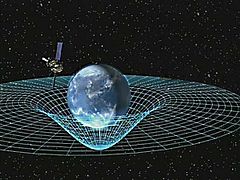
Back مبادرة توماس Arabic Thomas-Präzession German Thomasen prezesio Basque Précession de Thomas French Томасова прецесија Macedonian Прецессия Томаса Russian Прецесія Томаса Ukrainian 湯瑪斯進動 Chinese
| Part of a series on |
| Spacetime |
|---|
 |

In physics, the Thomas precession, named after Llewellyn Thomas, is a relativistic correction that applies to the spin of an elementary particle or the rotation of a macroscopic gyroscope and relates the angular velocity of the spin of a particle following a curvilinear orbit to the angular velocity of the orbital motion.
For a given inertial frame, if a second frame is Lorentz-boosted relative to it, and a third boosted relative to the second, but non-collinear with the first boost, then the Lorentz transformation between the first and third frames involves a combined boost and rotation, known as the "Wigner rotation" or "Thomas rotation". For accelerated motion, the accelerated frame has an inertial frame at every instant. Two boosts a small time interval (as measured in the lab frame) apart leads to a Wigner rotation after the second boost. In the limit the time interval tends to zero, the accelerated frame will rotate at every instant, so the accelerated frame rotates with an angular velocity.
The precession can be understood geometrically as a consequence of the fact that the space of velocities in relativity is hyperbolic, and so parallel transport of a vector (the gyroscope's angular velocity) around a circle (its linear velocity) leaves it pointing in a different direction, or understood algebraically as being a result of the non-commutativity of Lorentz transformations. Thomas precession gives a correction to the spin–orbit interaction in quantum mechanics, which takes into account the relativistic time dilation between the electron and the nucleus of an atom.
Thomas precession is a kinematic effect in the flat spacetime of special relativity. In the curved spacetime of general relativity, Thomas precession combines with a geometric effect to produce de Sitter precession. Although Thomas precession (net rotation after a trajectory that returns to its initial velocity) is a purely kinematic effect, it only occurs in curvilinear motion and therefore cannot be observed independently of some external force causing the curvilinear motion such as that caused by an electromagnetic field, a gravitational field or a mechanical force, so Thomas precession is usually accompanied by dynamical effects.[1]
If the system experiences no external torque, e.g., in external scalar fields, its spin dynamics are determined only by the Thomas precession. A single discrete Thomas rotation (as opposed to the series of infinitesimal rotations that add up to the Thomas precession) is present in situations anytime there are three or more inertial frames in non-collinear motion, as can be seen using Lorentz transformations.
© MMXXIII Rich X Search. We shall prevail. All rights reserved. Rich X Search